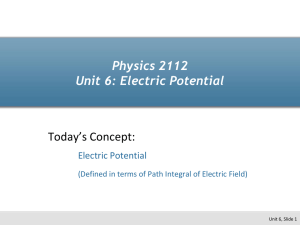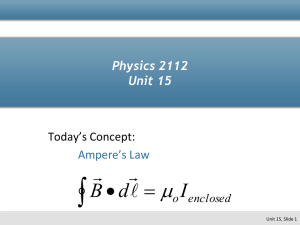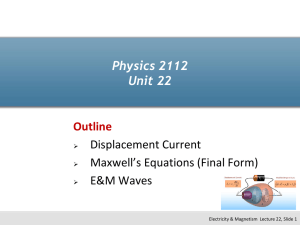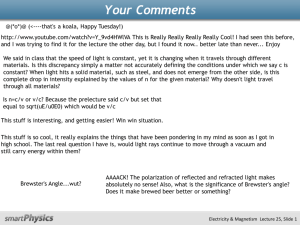ppt
advertisement
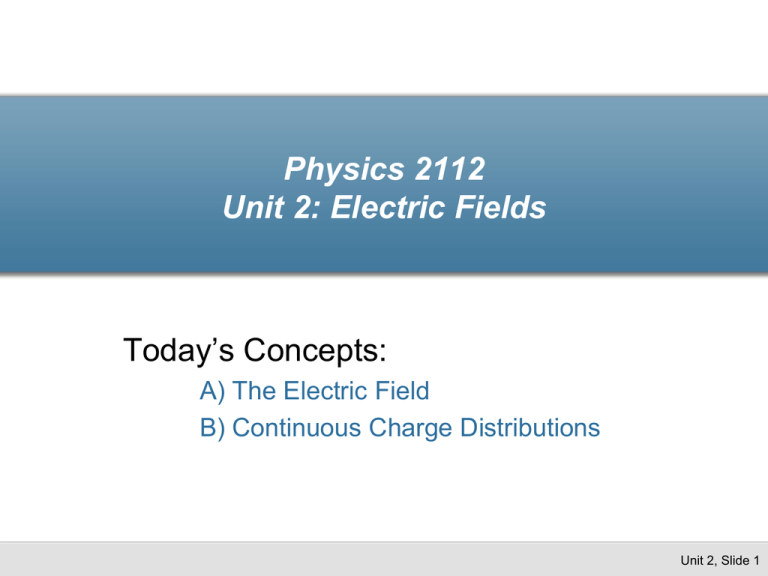
Physics 2112 Unit 2: Electric Fields Today’s Concepts: A) The Electric Field B) Continuous Charge Distributions Unit 2, Slide 1 Fields What if I remove q2? Is there anything at that point in space? 2 q2 q1 q1 F12 MATH: kq q F12 r 1 2 2 12 rˆ12 F E2 q 12 2 kq 1 2 12 r rˆ 12 Unit 2, Slide 2 Vector Field If there are more than two charges present, the total force on any given charge is just the vector sum of the forces due to each of the other charges: q2 q2 F4,1 F4,1 q1 F1 F2,1 F1 F3,1 F3,1 q4 q3 F2,1 q1 q4 F1 q3 F1 F2,1 F2,1 F3,1 kq q F1 r MATH: 1 2 2 12 F4,1 rˆ12 + kq 1 q 3 2 13 r +q1 -> -q1 rˆ 13 + kq 1 q 4 2 14 r rˆ14 F3,1 direction reversed F E q 1 1 F4,1 kq 2 2 12 r rˆ 12 + kq 3 2 13 r rˆ13 + kq 4 2 14 r rˆ14 Unit 2, Slide 3 Electric Field “What exactly does the electric field that we calculate mean/represent? “ “What is the essence of an electric field? “ F E q The electric field E at a point in space is simply the force per unit charge at that point. Electric field due to a point charged particle Superposition E Qi k r i 2 i Field points toward negative and Away from positive charges. rˆi q2 E4 E2 E E3 Field point in the direction of the force on a positive charge. Q E k 2 rˆ r q4 q3 Unit 2, Slide 4 CheckPoint: Electric Fields1 A x +Q -Q B Two equal, but opposite charges are placed on the x axis. The positive charge is placed to the left of the origin and the negative charge is placed to the right, as shown in the figure above. What is the direction of the electric field at point A? A. B. C. D. E. Up Down Left Right Zero Unit 2, Slide 5 CheckPoint: Electric Fields2 A x +Q -Q B Two equal, but opposite charges are placed on the x axis. The positive charge is placed to the left of the origin and the negative charge is placed to the right, as shown in the figure above. What is the direction of the electric field at point B? A. B. C. D. E. Up Down Left Right Zero Electricity & Magnetism Lecture 2, Slide 6 Example 2.1 (Field from three charges) +q 1 Calculate E at point P. P d -q 2 +q d 3 Electricity & Magnetism Lecture 2, Slide 7 CheckPoint: Magnitude of Field (2 Charges) In which of the two cases shown below is the magnitude of the electric field at the point labeled A the largest? A +Q +Q A -Q Case 1 A. B. C. +Q Case 2 Case 1 Case 2 Equal Electricity & Magnetism Lecture 2, Slide 8 + + + _ _ _ Electricity & Magnetism Lecture 2, Slide 9 CheckPoint Results: Motion of Test Charge A positive test charge q is released from rest at distance r away from a charge of +Q and a distance 2r away from a charge of +2Q. How will the test charge move immediately after being released? A. B. C. D. To the left To the right Stay still Other Electricity & Magnetism Lecture 2, Slide 10 Example 2.2 (Zero Electric Field) q1 (0,0) Q2 x (0.4m,0) A charge of q1 = +4uC is placed at the origin and another charge Q2 = +10uC is placed 0.4m away. At what point on the line connected the two charges is the electric field zero? Unit 2, Slide 11 Continuous Charge Distributions “I don't understand the whole dq thing and lambda.” Summation becomes an integral (be careful with vector nature) E Qi k r i i 2 rˆi E k dq r 2 rˆ WHAT DOES THIS MEAN ? Integrate over all charges (dq) r is vector from dq to the point at which E is defined Linear Example: l Q/L dE pt for E r charges dq l dx Electricity & Magnetism Lecture 2, Slide 12 Clicker Question: Charge Density “I would like to know more about the charge density.” Linear (l Q/L) Coulombs/meter Surface (s Q/A) Coulombs/meter2 Volume (r Q/V) Coulombs/meter3 Some Geometry A sph ere 4 R V sp h ere 4 3 Acylinder 2 RL 2 R V cylinder R L 3 2 What has more net charge?. A) A sphere w/ radius 2 meters and volume charge density r = 2 C/m3 B) A sphere w/ radius 2 meters and surface charge density s = 2 C/m2 C) Both A) and B) have the same net charge. Q A rV r 4 3 R Q B s A s 4 R 3 2 QA QB r 43 R 3 s 4 R 2 1 r 3s R Electricity & Magnetism Lecture 2, Slide 13 Example 2.3 (line of charge) “Please go over infinite line charge.” P y Let’s do one slightly different. r h dq l dx x Charge is uniformly distributed along the x-axis from the origin to x a. The charge density is l C/m. What is the x-component of the electric field at point P: (x,y) (0,h)? a Electricity & Magnetism Lecture 2, Slide 14 Clicker Question: Calculation y P Charge is uniformly distributed along the x-axis from the origin to x a. The charge density is l C/m. What is the x-component of the electric field at point P: (x,y) (0,h)? r h dq l dx x x a We know: E What is A) dx x 2 dq r 2 k dq r 2 rˆ ? dx B) a +h 2 2 C) l dx a +h 2 2 D) l dx x +h 2 2 E) l dx x 2 Electricity & Magnetism Lecture 2, Slide 15 Clicker Question: Calculation Charge is uniformly distributed along the x-axis from the origin to x a. The charge density is l C/m. What is the x-component of the electric field at point P: (x,y) (0,h)? dE y dE x P 2 r 1 x E We know: k dq r 2 rˆ x a dq l dx dq r 2 l dx x +h 2 2 Ex dE x What is dE x ? A) dE cos 1 B) dE cos 2 C)dE sin 1 D) dE sin 2 Electricity & Magnetism Lecture 2, Slide 16 Clicker Question: Calculation y dE Charge is uniformly distributed along the x-axis from the origin to x a. P The charge density is l C/m. What is the x-component of the electric field dE x 2 at point P: (x,y) (0,h)? E k dq r 2 1 rˆ r 2 x a dq l dx l dx x +h 2 2 Ex dE x dE sin 2 E x? A) x We know: dq What is r k l sin 2 x - dx 2 +h 2 B) a k l a sin 2 0 dx x +h 2 2 C) neither of the above sin DEPENDS ON x! 2 Electricity & Magnetism Lecture 2, Slide 17 Clicker Question: Calculation y Charge is uniformly distributed along the x-axis from the origin to x a. The charge density is l C/m. What is the x-component of the electric field at point P: (x,y) (a,h)? dE P dE x 2 r 1 x E k dq r 2 rˆ x a dq l dx We know: dq r 2 l dx x +h 2 2 Ex dE x dE sin 2 What is x in terms of Q ? A) x = h*tanQ 2 B) x = h*cosQ2 a Q C) x = h*sin a2 + h2 2 a D) x = h / 2cosQ 22 (a - x) + h Electricity & Magnetism Lecture 2, Slide 18 Calculation Charge is uniformly distributed along the x-axis from the origin to x a. The charge density is l C/m. What is the x-component of the electric field at point P: (x,y) (a,h)? dE y dE x P dE x 2 r 1 We know: E dq r 2 k dq r l dx x +h 2 2 rˆ Ex 2 x x a dq l dx dE x dE cos 2 x = h*tanQ dx = h*sec2Q d What is Ex (P) E x ( P ) kl f ? h * sec * sin 2 d (( h * tan ) 0 2 +h 2 ) E x ( P ) kl h h +a 2 2 - 1 Electricity & Magnetism Lecture 2, Slide 19 Observation y E x ( P ) kl h h +a 2 2 - 1 dE P dE x 2 since h h +a 2 2 1 Ex < 0 r 1 x a x dq l dx make since? Exercise for student: Change variables: write Q in terms of x Result: do integral with trig sub Electricity & Magnetism Lecture 2, Slide 20 Back to the pre-lecture y “Please go over infinte line charge. How does R get outside the intergral?” dE dE x P dE x 2 We had: E x ( P ) kl f h * sec * sin 2 d (( h * tan ) 2 0 kl f d 0 r +h 2 1 ) x sin a x dq l dx h to - 8 B) The limits would be + 8 How would this integral change if the line of charge were infinite in both directions? D) sinQ would turn to tanQ A) The limits would be Q1 to –Q1 E) sinQ would turn to cosQ C) The limits would be -/2 to /2 Electricity & Magnetism Lecture 2, Slide 21 Back to the pre-lecture y 2 For an infinite line of charge, we had: /2 E x ( P ) kl d - / 2 dE dE x P sin dE x r h 2 x 1 a x dq l dx How would this integral change we wanted the y component instead of the x component? A) The limits would be Q1 to –Q1 D) sinQ would turn to tanQ B) The limits would be +/- infinity E) sinQ would turn to cosQ C) The limits would be -/2 to /2 Electricity & Magnetism Lecture 2, Slide 22 k in terms of fundamental constants Note k E line 1 4 l r 2 o o 2lk r Unit 2, Slide 23 CheckPoint: Two Lines of Charge Two infinite lines of charge are shown below. Both lines have identical charge densities +λ C/m. Point A is equidistant from both lines and Point B is located a above the top line as shown. How does EA, the magnitude of the electric field at point A, compare to EB, the magnitude of the electric field at point B? A. EA < EB B. EA = EB C. EA > EB Electricity & Magnetism Lecture 2, Slide 24 Example 2.4 (E-field above a ring of charge) P y x What is the electric field a distance h above the center of ring of uniform charge Q and radius a? h a Unit 2, Slide 25 Example 2.5 (E-field above a disk) P y x What is the electric field a distance h above the center of disk of uniform charge Q and radius a? h a Unit 2, Slide 26 dipoles -q +q Cl q Na q d Dipole moment = p = qd Points from negative to positive. (opposite the electric field.) Unit 2, Slide 27 Torque on dipole +q -q = 2*(qE X d/2) Q =pXE dU= -dW = dQ = pE*sinQ*dQ DU -pEcosQ Define U = when Q = /2 U -p E Unit 2, Slide 28 Example 2.6 (Salt Dipole) + - 20o The two atoms in a salt (NaCl) molecule are separated by about 500pm. The molecule is placed in an electric field of strength 10N/C at an angle of 20o. What is the torque on the molecule? What is the potential energy of the molecule? Unit 2, Slide 29

